|
|
 |
|
Cyclopoida ( Order ) |
|
|
|
Lubbockiidae ( Family ) |
|
|
|
Homeognathia ( Genus ) |
|
|
| |
Homeognathia brevis (Farran, 1908) (F,M) | |
| | | | | | | Syn.: | Lubbockia brevis Farran, 1908 b (p.96, Descr.F, figs.F); Rose, 1933 a (p.305, figs.F); Sewell, 1948 (p.483, 506); Boxshall, 1977 a (p.121, Descr.M, figs.M); Heron & Damkaer, 1978 (p.4); Heron & al., 1984 (p.455, Redescr.F,M, figs.F,M);
Ref. compl.: C.B. Wilson, 1950 (p.254, Rem.); Pavlova, 1966 (p.45); Björnberg, 1973 (p.364, 387); Boxshall, 1977 b (p.551); Kovalev & Shmeleva, 1982 (p.86); Uysal & al., 2002 (p.18, tab.1); Kosobokova & Hopcroft, 2010 (p.96, Table 1); Kosobokova & al., 2011 (p.29, Table 2, Rem.: Arctic Basins) | | | | Ref.: | | | Huys & Böttger-Schnack, 1996/97 (p.260); Boxshall & Halsey, 2004 (p.577); Vives & Shmeleva, 2010 (p.247, figs.F,M, Rem.) | 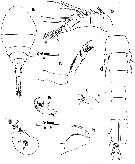 issued from : G.A. Boxshall in Brit. Mus. nat. Hist., Zool., 1977, 31 (3). [p.120, Fig.9]. Male (from 18°N, 25°W): a, habitus (dorsal); b, A1 (ventral); c, A2 (anterior); d, urosome (ventral); e, Md (anterior); f, Mx1 (posterior); g, Mx2 (anterior); h, Mxp (anterior). Nota: Prosome very broad and twice as long as the urosome.Caudal rami just longer than anal somite. A1 7-segmented. A2 3-segmented. mx1 bilobed; inner lobe with 2, outer lobe with 3 setae. Mxp 3-segmented; middle segment with a row of fine spinules on inner margin; terminal claw unarmed. P5 a free segment with a long apical seta and a short lateral seta. P6 represented on genital complex by a short postero-lateral projection with a apical spinule.
|
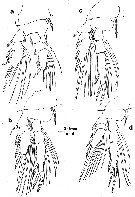 issued from : G.A. Boxshall in Brit. Mus. nat. Hist., Zool., 1977, 31 (3). [p.122, Fig.10]. Male: a-d, P1 to P4 (posterior).
|
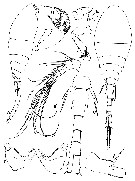 issued from : G.A. Heron, T.S. English & D.M. Damkaer in J. Crustacean Biol., 1984, 4 (3). [p.462, Fig.7]. As Lubbockia brevis. Female (from Arctic): A-B, habitus (lateral and dorsal, respectively; scale bar: y); C, urosome (ventral; scale bar: w); D, rostrum (ventral; zcale bar: v); E, right A1 (scale bar: W); F, left A2 (scale bar: w); G, labrum (ventral; scale bar: x); H, left Md (scale bar: x); I, right Mx1 (scale bar: x).
|
 issued from : G.A. Heron, T.S. English & D.M. Damkaer in J. Crustacean Biol., 1984, 4 (3). [p.463, Fig.8]. As Lubbockia brevis. Female: A, right Mx2 (scale bar: x); B, right Mxp (scale bar: w); C-F, P1 to P4 (scale bar: w).
|
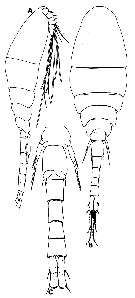 issued from : G.A. Heron, T.S. English & D.M. Damkaer in J. Crustacean Biol., 1984, 4 (3). [p.464, Fig.9, A-C]. As Lubbockia brevis. Male: A-B, habitus (lateral and dorsal, respectively; scale bar: y); C, urosome (ventral; scale bar: w).
|
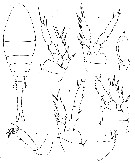 issued from : G.P. Farran in Fish. Ire. Sci. Invest., 1906, II [1908]. [Pl. XI, Figs.1-8]. As Lubbockia brevis. Female (from 54°50'N, 10°30'W): 1, habitus (dorsal); 2, P2; 3, P3; 4, Mxp; 5, A2; 6, P4; 7, P1; 8, Mx2.
| | | | | Compl. Ref.: | | | Benedetti & al., 2016 (p.159, Table I, fig.1, functional characters) | | | | NZ: | 6 | | |
|
Distribution map of Homeognathia brevis by geographical zones
|
| | | | | | | Loc: | | | off NW Ireland, Arct. (Chukchi Sea, Nansen Basin, Amundsen Basin, Makarov Basin, Canada Basin), Cape Verde Is., Medit. (W Basin, Aegean Sea, Lebanon Basin), Philippines (in C.B. Wilson, 1950), Chile (38°- 40°S; in Björnberg, 1973) | | | | N: | 11 | | | | Lg.: | | | (24) F: 0,85; (139) M: 1,43; 1,18; (675) F: 1,04-0,88; M: 0,94-0,84; {F: 0,85-1,04; M: 0,84-1,43} | | | | Rem.: | bathypelagic.
For Heron & al. (1984, p.459) this species bears a close resemblance to L. flemingi (= Homeognathia flemingi), but may be separated by the longer spiniform setule of P6 and proportionally longer caudal ramus for both sexes. | | | Last update : 20/02/2018 | |
|
|
 Any use of this site for a publication will be mentioned with the following reference : Any use of this site for a publication will be mentioned with the following reference :
Razouls C., Desreumaux N., Kouwenberg J. and de Bovée F., 2005-2025. - Biodiversity of Marine Planktonic Copepods (morphology, geographical distribution and biological data). Sorbonne University, CNRS. Available at http://copepodes.obs-banyuls.fr/en [Accessed December 27, 2025] © copyright 2005-2025 Sorbonne University, CNRS
|
|
 |
 |









